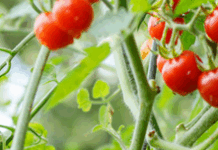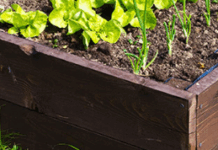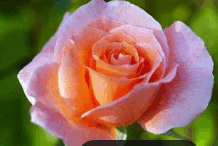https://hnr.k-state.edu/extension/info-center/newsletters/index.html
Blog Post: http://www.ksuhortnewsletter.org
Video of the Week: Growing Vegetables in Containers
https://kansashealthyyards.org/all-videos/video/spring-summer
REMINDERS
Break up crust on soil of vegetable garden after heavy rain to allow roots to breathe.
No need to spray for cedar-apple rust after May 31.
Don’t work soil too wet. Squeeze a handful of soil and push your finger into the soil. It will crumble if it is dry enough to work.
Take care of weeds when they are small as they are easier to control and will not compete with your vegetables or flowers. Consider using a scuffle hoe as they are quick to use and are less likely to bring weed seeds to the surface.
VEGETABLES
Walnut Wilt
Juglone is a chemical produced in the leaves, fruit hulls and inner bark of trees in the walnut family (Juglandaceae) including: black walnut (highest producer), Persian walnut, butternut and pecan. With rain, the chemical is leached into the soil. The fungicidal and insecticidal properties of juglone make it toxic to many plants causing wilting and stunting. Plants grown closer to these allelopathic trees may show worse symptoms as they come in contact with the tree roots. Susceptible plants, such as tomatoes, grown next to a walnut tree may wilt and die prematurely whereas those grown further away may have stunted growth, but survive. Even if the affected plants do produce fruit, it may have a less desirable, nutty taste.
Symptoms of walnut wilt may resemble those of fusarium and verticillium wilt including wilting and yellowing leaves that eventually drop. Stem tissue may also turn brown. The diseases can be distinguished by the presence of trees from the walnut family.
Tree removal does not provide an immediate control as the toxicity can remain in the soil and debris for multiple years. Avoid growing the following susceptible plants near Juglandaceaes: tomato, potato, blackberry, apple, lilac, asparagus, chrysanthemum, peony along with many other herbaceous and woody plants. Some walnut wilt resistant plants include, but are not limited to: black raspberry, corn, bean, carrot, dandelion and zinnia. (Cynthia Domenghini)
Colorado Potato Beetle
The Colorado Potato Beetle is just under 1/2″ long. Oval-shaped beetles have black and yellowish-colored stripes on the wings. The larvae have two rows of black spots on each side of the red-pink body. The larvae and adults will feed on susceptible plant leaves causing extensive damage including defoliation and yield losses if left untreated.
Females emerge in late April after overwintering, laying clusters of bright yellow eggs on young potato plants. Larvae mature in about three weeks and pupate in the soil. Ten days later adult beetles emerge, mate and lay more eggs.
While the preferred crop is potatoes, this pest will feed on tomatoes, eggplants and peppers as well. Recommended control strategies include:
Hand Picking: Feasible on a small scale with regular monitoring. Remove beetles and larvae to a container of soapy water.
Floating Row Cover: Create a physical barrier between your plants and the pest with a lightweight spun polyester or other fabric. It is important to seal the edges of the cover and since potatoes do not need to be pollinated, the row cover can remain in place during the growing season. However, this creates an obstacle for maintaining weeds in the rows.
I nsecticides: Registered products include: Spinosad (Captain Jack’s Dead Bug Brew, Bonide Colorado Beetle Beater Concentrate, Monterey Garden Insect Spray) and permethrin (Eight Vegetable, Fruit & Flower Concentrate, Hi Yield Garden and Farm Insect Control). (Cynthia Domenghini)
FRUIT
Thinning Excess Fruit
Thinning fruit is beneficial to trees for multiple reasons. A heavy fruit crop one year can inhibit the fruit growth the following year and may prevent a harvest altogether. Thinning fruit can also direct the tree’s stored energy to the remaining fruit allowing it to fully mature and grow larger. Third, allowing tree branches to become overloaded with fruit can lead to branches breaking.
The amount of thinning that should be done depends on the type of fruit tree. These recommendations are general guidelines to allow proper fruit development.
Apples and pears: Fruit should be six to eight inches apart leaving only the largest, nicest fruit in each cluster.
Peaches: Fruit should be six to eight inches apart with only one fruit per cluster.
Plums and Prunes: Fruit should be four to five inches apart.
Apricots: Fruit should be two to four inches apart.
Cherries: No thinning required
Thinning can be done using pruners to clip off the fruit or by snapping them off by hand. Use caution to support the fruit as you snap to avoid breaking the branch. (Cynthia Domenghini)
Remove Blossoms on Newly Planted Strawberries
Newly planted strawberries have limited energy which should be directed towards developing runners rather than fruit production. Remove blooms from young spring-bearing strawberries to promote strong runners early in the plant’s life that will produce berries the following year. Failure to do so will result in weak runners and small/fewer fruit.
Remove fruit from young everbearing strawberry plants for the first four to six weeks after planting so energy will be directed to root development. (Cynthia Domenghini)
MISCELLANEOUS
Bristly Rose Slug
This insect has been skeletonizing rose leaves in various areas around the state. This is not a caterpillar but is the larva of a sawfly. Close examination of this small (½ inch) larva will reveal very fine, hairlike spines in clusters.
Young larvae will remove the green layer of a leaf leaving behind a clear material. As the larvae mature, they make holes in the leaf and eventually may consume all of the leaf but the major veins.
Since these insects are not caterpillars (larvae of moths or butterflies), BT, found in Dipel and Thuricide will not be an effective treatment. However, a strong jet of water will dislodge the slugs and make it difficult for them to return to the plant. Other effective treatments include insecticidal soap, horticultural oils, spinosad (Natural Guard Spinosad, Monterey Garden Insect Spray or Captain Jack’s Deadbug Brew) and permethrin (Eight Vegetable, Fruit and Flower Concentrate; Hi-Yield Lawn, Garden, Pet & Livestock Insect Spray). (Ward Upham)
Helping Roundup (Glyphosate) Products Be More Effective
The non-selective herbicide, glyphosate (Roundup, Killzall, Pronto Weed & Grass Killer) is a contact spray that should be mixed with water and sprayed onto undesired plants. The efficacy of this herbicide can be affected by the quality of the water mixed in. Water hardness is a measure of how much salt is in the water whereas harder water indicates higher salt content. Positively charged calcium and magnesium salts are particularly problematic because of they can bind with the negatively charged glyphosate molecules. This inhibits plants from absorbing the glyphosate.
Ammonium sulfate is negatively charged and can bind to hard water ions if added to the spray tank before the glyphosate. This allows the glyphosate to work as intended and may even increase efficacy of weed control as the herbicide may be absorbed more readily by weeds.
Adding ammonium sulfate to soft water is not helpful. Test your water to determine the level of hardness. If your water is above 120 ppm it is at a level that could benefit from including ammonium sulfate in glyphosate mixes. In general, add 8.5 pounds of ammonium sulfate per 100 gallons of water (1.4 ounces per gallon; 4 TBSP per gallon). (Cynthia Domenghini)
Three Steps to Choosing Potting Media for Outdoor Use: Part 1
I have had several questions this spring on potting soils and how to choose the best potting media. Dr. Cheryl Boyer, our Nursery Crop and Marketing Specialist, has done extensive studies on potting soils and has written the following to help homeowners make a good choice. We will present her material is three parts or steps with one step each week.
Step 1: What are You Using it For?
Step 2: Understanding Major, Minor, and Specialty Components
Step 3: Mixing and Managing
So, here is this week’s post. (Ward Upham)
There are a lot of choices in the potting media aisle of your local garden center. If you don’t know what you’re looking for, it can be a confusing experience to read the label. Fortunately, there are three easy steps/considerations for screening the available choices down to one that works for your needs.
Step 1: What are You Using it For?
It does make a difference whether you are planning to use media in a container or as a soil amendment in a raised vegetable bed or landscaping bed. Some materials are designed to hold water well while others are designed to drain well. What do you need for each of those situations?
· Growing plants in containers: Generally, you want to use a peat-based soil-less substrate for this application. Do not use field soil. These products are engineered for success in season-long growth of annual plants in containers of reasonable size for consumer use (very large containers are a different discussion). Peat-based mixes almost always have a “starter charge” of fertilizer mixed in to get your plants growing, but you’ll need to supplement with fertilizer as the season progresses. Old potting media has likely lost its starter charge and may, in fact, become hydrophobic (repels water) over time. You’ll need to spend some time rewetting and mixing old potting media for a new season if you intend to re-use it.
· Amending a landscape bed or raised bed: Products containing peat should not be the primary component but are acceptable in small quantities. Field soil mixed with compost and perhaps a coarse pine bark-size material is best in this situation. The objective is to enrich your existing soil with natural material that will break down over time and in the meantime provide nutrients and aeration for roots to grow well. Make sure to apply the material and mix/till it into a broad area and not just a single planting hole or your new plants may experience the “soup bowl effect” and succumb to rapid decline. Check with your local landscape contractor to get a large volume of soil delivered, perhaps even mixed with compost from a local municipal composting facility. (Cheryl Boyer)
TURF
Time to Fertilize Warm-Season Grasses
Tne is the time to fertilize warm-season lawn grasses such as bermudagrass, buffalograss, and zoysiagrass. These species all thrive in warmer summer weather, so this is the time they respond best to fertilization. The most important nutrient is nitrogen (N), and these three species need it in varying amounts.
Bermudagrass requires the most nitrogen. Bermudagrass used on athletic fields needs about 4 lbs. nitrogen per 1,000 sq. ft. during the season. High-quality home lawns are often given 3 pounds per 1000 square feet and low maintenance areas can get by on 2 lbs.. Apply this as separate applications, about 4 weeks apart consisting of 1 lb. N per 1,000 sq. ft. starting in early May for athletic fields. It is already too late for the May application, but the June application is just around the corner. The nitrogen can come from either a quick- or slow-release source. So any lawn fertilizer will work. Plan the last application for no later than August 15. This helps ensure the bermudagrass is not overstimulated, making it susceptible to winter-kill.
Zoysiagrass grows more slowly than bermudagrass and is prone to develop thatch. Consequently, it does not need as much nitrogen. In fact, too much is worse than too little. One and one-half to 2 pounds N per 1,000 sq. ft. during the season is sufficient. Split the total in two and apply once in early June and again around mid-July. Slow-release nitrogen is preferable but quick-release is acceptable. Slow-release nitrogen is sometimes listed as “slowly available” or “water insoluble.”
Buffalograss requires the least nitrogen of all lawn species commonly grown in Kansas. It will survive and persist with no supplemental nitrogen, but giving it one lb. N per 1,000 sq. ft. will improve color and density. This application should be made in early June. For a little darker color, fertilize it as described for zoysiagrass in the previous paragraph, but do not apply more than a total of 2 lb. N per 1,000 sq. ft. in one season. As with zoysia, slow-release nitrogen is preferable, but fast-release is also OK. As for all turfgrasses, phosphorus and potassium are best applied according to soil test results because many soils already have adequate amounts of these nutrients for turfgrass growth. If you need to apply phosphorus or potassium, it is best to core aerate beforehand to ensure the nutrients reach the roots. (Ward Upham)
Contributors:
Cynthia Domenghini,. Instructor (cdom@ksu.edu)
Cheryl Boyer, Nursery Specialist (crboyer@ksu.edu)
Ward Upham, Extension Associate (wupham@ksu.edu)
Division of Horticulture
1712 Claflin, 2021 Throckmorton
Manhattan, KS 66506
(785) 532-6173
For questions or further information, contact: wupham@ksu.edu OR cdipman@ksu.edu
This newsletter is also available on the World Wide Web at: http://hnr.k-state.edu/extension/info-center/newsletters/index.html
The web version includes color images that illustrate subjects discussed. To subscribe to this newsletter electronically, send an e-mail message to cdipman@ksu.edu or wupham@ksu.edu listing your e-mail address in the message.
Brand names appearing in this newsletter are for product identification purposes only. No endorsement is intended, nor is criticism implied of similar products not mentioned.
K-State Research and Extension is committed to making its services, activities and programs accessible to all participants. If you have special requirements due to a physical, vision or hearing disability, or a dietary restriction please contact Extension Horticulture at (785) 532-6173.
Kansas State University Agricultural Experiment Station and Cooperative Extension Service K-State Research and Extension is an equal opportunity employer. Issued in furtherance of Cooperative Extension Work, Acts of May 8 and June 30, 1914, as amended. Kansas State University, County Extension Councils, and United States Department of Agriculture
Cooperating, Ernie Minton, Dean.





